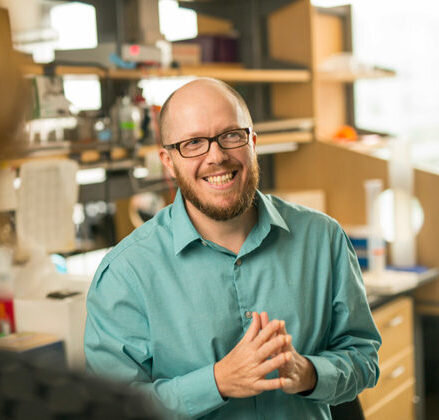Vanderbilt researchers have identified the protein receptor in specialized heart cells that, when removed, preserves cardiac function after a heart attack. This discovery has significant implications for survival after a heart attack, with a promising therapeutic development now underway at the Warren Center for Neuroscience Drug Discovery.
The article, “Targeting 5-HT2B Receptor Signaling Prevents Border Zone Expansion and Improves Microstructural Remodeling after Myocardial Infarction,” was published in the journal Circulation on Jan. 21.
The research was led by David Merryman, a professor of biomedical engineering who holds the Walters Family Chair, with experiments conducted by Caleb Snider, a former Vanderbilt graduate student and current postdoctoral fellow at Washington University in St. Louis, and others. The team used genetic and drug models to confirm that removal of serotonin 2B receptors within cardiac fibroblasts—”worker bee” cells that produce connective tissue in the heart—help the organ heal significantly after a heart attack.
Typically, only a small region of the heart dies during a heart attack (myocardial infarction), but over time the borders of the scarred region expand. The resulting stress on the heart to do more with less induces heart failure. The researchers set out to figure out what exactly the protein receptor was responsible for during heart attacks and how it might be altered for improved outcomes.
Heart health is measured by ejection fraction—how well the heart is pumping. Normally, an animal has an 80 percent ejection fraction, which decreases by half following a heart attack. In models in which serotonin 2B was either treated by a drug or genetically removed, the heart had a 50 percent greater ejection fraction six weeks after a heart attack than models in which serotonin 2B remained in cardiac fibroblasts, Merryman explained.
The biggest metric in this study was cardiac function, measured through echocardiography. Through biomechanical characterization of the scar and the adjacent border zone, the researchers measured how scar tissue structure and function changed. They found that an early inhibition of serotonin 2B after a heart attack results in a functional scar that is less likely to expand beyond the initial wound to put additional pressure on the heart.
“We found that the drug models have an acute and long-term effect,” Merryman said. “The drug treatment preserves cardiac function six weeks after a heart attack to a much greater extent than the control group, and it effectively contains the border zone of the affected area of the heart from worsening.”
Merryman is collaborating with Craig Lindsley, the William K. Warren, Jr. Professor of Medicine, University Professor of Pharmacology, Biochemistry and Chemistry, and director of the WCNDD, to develop a highly targeted molecule that impacts only serotonin 2B in the cardiopulmonary system where the receptor is highly prevalent. The molecule will be designed to not cross the blood brain barrier, thus avoiding neurological side effects. The researchers have conducted three rounds of medicinal chemistry and are reviewing the molecule’s efficacy.
“This molecule has the possibility to not only treat myocardial infarction, but also high blood pressure in the lungs that is known as pulmonary arterial hypertension,” Merryman said. “We are working with many clinicians to sort out the best path for drug development that we think has significant implications for human health.”
Treatment shows reduction in heart failure after myocardial infarction
More information:
J. Caleb Snider et al. Targeting 5-HT2B Receptor Signaling Prevents Border Zone Expansion and Improves Microstructural Remodeling after Myocardial Infarction, Circulation (2021). DOI: 10.1161/CIRCULATIONAHA.120.051517
Provided by
Vanderbilt University
Citation:
Discovery shows how to treat heart attacks—new drug development underway (2021, February 12)
retrieved 15 February 2021
from https://medicalxpress.com/news/2021-02-discovery-heart-attacksnew-drug-underway.html
This document is subject to copyright. Apart from any fair dealing for the purpose of private study or research, no
part may be reproduced without the written permission. The content is provided for information purposes only.



